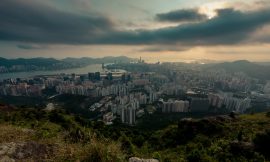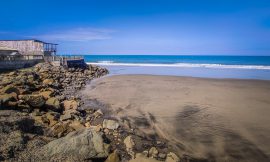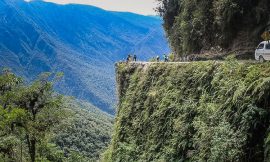The capital city of Ecuador, Quito, was among the first ones to be named a UNESCO World Heritage site. Its vast historic city center is so well preserved that it’s like going back in time to colonial Spain. Since the city is located between mountains, the geographical terrain is hilly with ravines which make the city take a long and narrow shape. This should be taken into consideration when picking a place to stay since it can take at least an hour to traverse the city from north to south. Quito is also the closest city to the equator which lies to the north of the city and has a monument dedicated to it. Being so close to the sun, the climate is naturally hot. However, being located in the mountains, the weather is unpredictable and changes throughout the day. It is normally chilly in the early morning/evenings and hot throughout the day reaching its peak at midday. Sunblock is a must and you should always leave with a sweater in case you get back at night when it’s cooler. Being a modernizing and metropolitan city there are many things to do in the city. Being my natal city, I could go on and on about all the things there are to do, so I’ll go over some which I find the most interesting.
Convento de San Francisco
The largest religious complex in the historic city center was built over a period of 150 years between the 16th and 17th century. It’s located in Plaza de San Francisco and not only is it full of history but also bears a local legend. The legend of Cantuña tells the tale of an indigenous native being tasked with building the atrium by the Franciscan priests. Cantuña ambitiously promised he would get it done in 6 months. He brought together a group of indigenous workers for the construction but they didn’t progress as quickly as Cantuña had hoped. The day before the deadline, the devil appeared before Cantuña and offered to help him finish construction in exchange for his soul. Cantuña accepted but on the condition that every last stone would be put in place by the deadline. The devil agreed and got his demons to work on it and they progressed quickly finishing by the deadline. So when the day came, the devil returned to claim Cantuña’s soul. However, Cantuña had covertly hidden a stone before the demons started working and told the devil the construction was not fully completed. The devil, ashamed of being fooled by a mere mortal returned to hiding in the depths of hell. There’s a tombstone of Cantuña in one of the chapels so the person exists, but it’s not known how the legend came about or which stone is missing. Part of the Convent has been turned into a museum and costs only 2 USD1. It exhibits the history of the convent and has seasonal exhibitions. There are many chapels and the main church has much of its detailed interior decor bathed in gold.










La Basilica del Voto Nacional
Inspired by the Notre Damme and Bourges cathedrals, La Basilica is a magnificent structure with details local to the region. The gargoyles are not like the typical ones found in other basilicas, instead, they are of animals native to Ecuador. Plans to build the La Basilica began in 1882 but the first stone was only laid in 1892. Construction took over 30 years and although it appears to be finished, it’s not officially completed. Local legend states that the end of the world will arrive if the La Basilica is ever finished. Entrance costs 2 USD with access to the towers. The altitude can make climbing the winding steep steps tiring but it is the highlight of the visit. Given that the La Basilica is located in the city center, it yields breathtaking views of the city and an unobstructed view of El Panecillo.










TeleferiQo
The TeleferiQo is found west of the city center and go up the east side of the Pichincha volcano. The easiest way to get there is via taxi/Uber2 since it is off the Occidental Highway. The bus would leave you on the highway where you would have to walk uphill for about 30-45 minutes to the park entrance. A taxi/Uber on the other hand would leave you at the entrance. There are two entrances; one is for Vulqano Park which is a small theme park and the other is for the TeleferiQo. If you take a taxi/Uber, make sure to tell them you wish to be dropped off at the entrance to TeleferiQo as this is further uphill. The ticket office is right next to the cable car entrance and it costs 8.50 USD. Make sure you bring ID as this is required to purchase a ticket. This is done as a security measure to track visitors who have gone up and come back down. Once you have your ticket, you can then queue up at the entrance where the operators will instruct you to get on. You are also told to keep your ticket for the way back. If you don’t have it, you’ll need to buy another one at the top. The ascent of over 800 meters to 3945 meters above sea level and takes around 20 minutes.
Once at the top, you’ll notice it is a lot windier and chilly so make sure to take warm clothing. There are a few shops/stalls and a cafe that sells coca tea to help with altitude sickness. As soon as you step out of the cable car there is a viewpoint looking out towards the city center. There is another viewpoint a short walk down going left as you exit the cable car station. This viewpoint looks out towards the south of the city and has two giant chairs which make for great pictures. From here you can see just how far the city stretches south. It has grown so much that it is no longer possible to see the city limits. On a clear day, you’ll also be able to see the volcanoes in the vicinity. There is a panel which illustrates their location and displays some information on them. Once you have taken in the sights from here, you can continue on a short 10-minute walk upwards towards another viewpoint. This viewpoint also looks out towards the city center and has some swings which get pretty busy as everyone wants to take pictures with them. For most tourists, the journey ends here and they’ll make their way back down. However, for the more adventurous ones, it is possible to hike all the way up to the summit of Rucu Pichincha. The hike to the summit at 4696 meters takes about 3-4 hours depending on your fitness and whether you’ve taken time to acclimatize to the altitude. Being at almost 4000 meters above sea level, just walking is tiring so hiking uphill and at some point doing some rock climbing can be exhausting. The reward is definitely worth it though as the views from the summit are the best in the city and if you’re lucky enough to get up there on a clear day, you’ll be able to see the surrounding volcanos. If you decide to do the hike, go as early as possible since the weather in the mountains tends to be clear early in the day with clouds approaching in the early afternoon.













